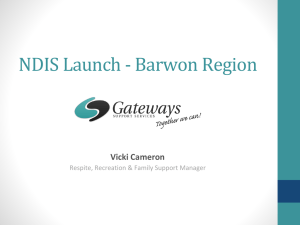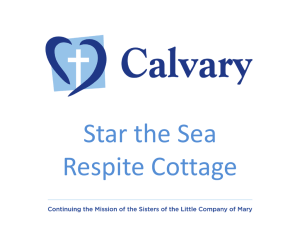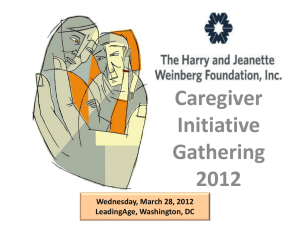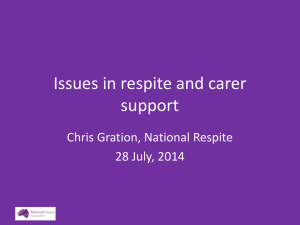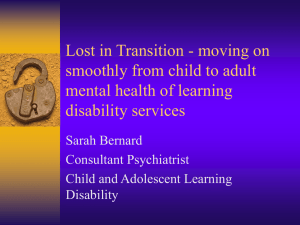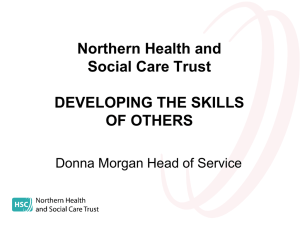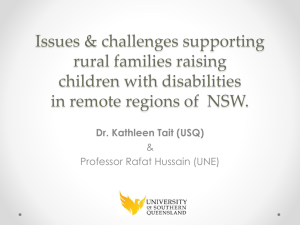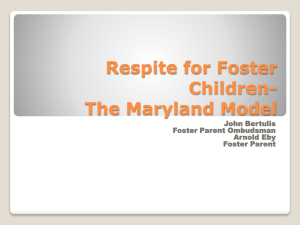The Respite Learning Portal - ARCH-NRN
advertisement
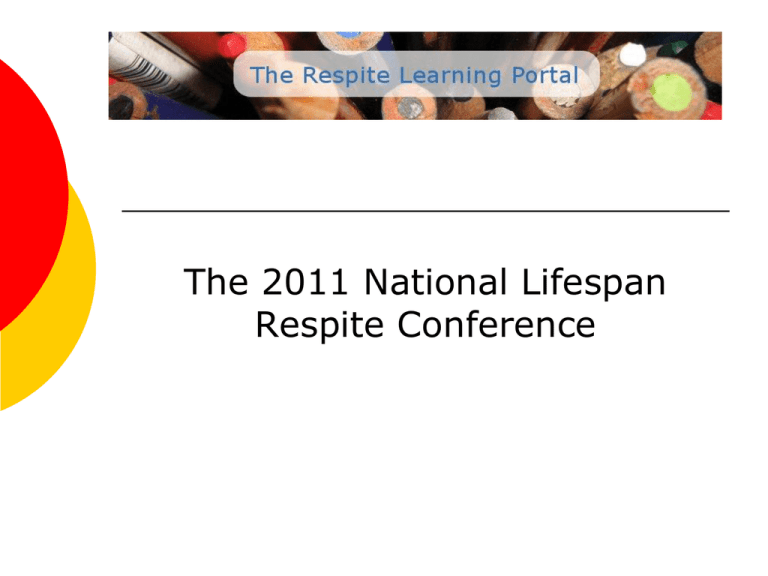
The 2011 National Lifespan Respite Conference Setting the Stage Respite services in Ontario. Many families who have children and adults with disabilities have individualized funding known as Special Services at Home or Passport. They develop their own flexible respite supports with these funds. Respite agencies assist them to recruit people to provide the support. There is also special funding to provide respite support for children with autism, complex medical needs and mental health challenges. Supporting Families There are also many agencies across Ontario that coordinate respite supports to families. These supports include: Center based respite (often weekend/over night) In home respite (a few hours per week) Out of home respite (associate/host family model) Community based (e.g. supports in community recreation programs) Support also includes: assistance with recruitment, screening and training of respite providers, administration of funds and coordination with other kinds of services that the family may be receiving. Respite Services Parents can arrange their own flexible support with the funding that they receive or Parents can utilize services of agencies in arranging respite. _______________________ There are 9 regions within the province of Ontario and each has designated funding for respite care for children. Demand for service often exceeds the funding that is available. Communities of Practice An “Ideal Model” was created for Respite/Short Break Care in some areas of Ontario that outlined the blueprint for respite services. The vision is to provide flexible, responsive, planned respite support for families. As this model was developed, two key components were identified: Best and Promising of Practice developing communities of practice so that agencies could share best and promising practices with one another. Training developing training supports for respite providers so that families could have the kind of support that they need. How the Training Partnership Evolved The South Western Region holds Communities of Practice meetings to determine common issues, needs and ways to share resources and share best/promising practices. Training was identified as a priority for the respite providers. While “in person” training continues, it was the goal of the group to develop on line training so that there would be a consistent message, ease of access and a well developed training package. Meanwhile the government had approached Safeguards Training to see if it would produce classroom style respite training. The Training Partnership Family Respite Services Windsor Essex Safeguards Training for Children and Adult Services Funding from the Ontario Ministry of Children and Youth Services Family Respite Services (Windsor Essex) Family Respite Services is an community agency that provides support to families who have children (0-18) with disabilities, including developmental, physical, and mental health challenges. Services are flexible. There is a range of services including in home, center based and community based options. FRS supports approximately 900 children in a community. Windsor is located across the river from Detroit Michigan. FRS has about 400 active respite providers. The agency screens more than 100 respite providers each year. FRS was anxious to develop a training course that would assist in the screening process, would communicate key values and would provide a consistent training process. Safeguards Training For Children and Adult Services Safeguards is a non profit, training partnership of 5 provincial associations serving over 350 agencies and 20,000 staff. Safeguards Partners: Association of Native Child and Family Services Agencies of Ontario Children’s Mental Health Ontario Community Living Ontario Ontchild/YPRO Ontario Association of Residences Treating Youth The service sectors involved include: Disability (Lifespan) Respite Children’s mental health Native Child and Family Services/Child Welfare Foster care, Treatment group homes Young Offenders - Open Custody Young Parent Resource Centres Street Youth Abuse/Trauma Treatment Our Mission To enhance the capacity of services through evidence-informed training for staff serving children, youth, families and adults. Types of Training Live training Online Learning Webinars Videoconference Customized and In-service Training Online Resource Portal (Virtual Library of journals, data, books) Trainers Bureau/Consulting Considerations in developing Training Model for the SW Region The Southwest Region of Ontario is a very diverse and large area. It includes rural areas, small towns, midsize and larger size cities. Agencies reported high drop-out rates and large investment up-front in orientations and trainings. Agencies identified that they wanted training that was easy to access and was easy for them to administer. Caregivers had differing schedules and it was hard to find a common times for training. Consistency Agencies wanted training that: was consistent across the region provided a basic level of training provided an orientation to candidates interested in being a caregiver. Input from Families Families reported that it was important to them to be able to contract with people who have adequate training to care for their son or daughter with a disability. Potential Uses for the Training Screening of potential candidates. Orientation and training. Tool for parents who are screening their own workers. Emphasizing Values Requiring people to take the course as a part of screening allows the agencies to: provide orientation about a common philosophy, discuss the importance of inclusion, review and train about the actual duties and role of someone providing the support Determine a potential caregivers commitment. Why Online Training for Respite? Consistency Each participant receives the same training. Cost-effective Reduces the number of orientation sessions and drop-out rates. Cost-effective to create as a training tool. Quality Participants must pass course requirements to receive a certificate. Reduced Waiting Certificates emailed directly upon successful completion. Affordable The administrative fee is only $25 Anywhere/Anytime Training is available 24 hours a day, 7 days a week. Respite Services Training Certificate Defining Learning Outcomes By the end of the course, Caregivers will be able to: Support a person in a “meaningful life” Define clear boundaries, expectations Have active listening skills Create a positive environment to handle situations Implement good health and safety practices Recognize signs of abuse and response procedures Properly bring closure to a respite relationship Developing a Course Outline Module Module Module Module Module Module Module Module Module Module Module Module 1: 2: 3: 4: 5: 6: 7: 8: 9: 10: 11: 12: The World of Respite Support: An Overview People You Will Support How to Support a Person in a Meaningful Life Communication Boundaries Personal Care Creating a Positive Environment Confidentiality Health and Safety Abuse Closure Quiz and Summary Course Features Glossary and Resources Addressing Learning Styles Engaging Carers in Discussion Interactive Pre and Post Activities Encouraging on-going learning The Respite Learning Portal The Respite Learning Portal is now the gateway to: Online training Webinars Resources Links to agencies Articles Polls Network with others through Discussion Boards. Over 3,500 people have now taken Respite courses and webinars. Respite Care for People with Autism Course Outline: Module Module Module Module Module Module 1: 2: 3: 4: 5: 6: Your Roles as a Respite Worker Understanding Autism Spectrum Disorder Communication Social Interaction and Play The Unique World of ASD Strategies for Positive and Enriching Respite Care Video Streaming Quizzes with added learning value Interactivity and Coaching Respite Workers, Autism and Your Child: A Parent's Guide 1. 2. 3. 4. 5. 6. 7. 8. 9. Your Child's Unique Personality Recruiting and Interviewing a Respite Care Provider Orientation with Your Respite Provider Keeping Things Safe Training Your Worker to Communicate with Your Child Keeping the Relationship Going Modifying Activities for Your Child Helpful Resources Summary Increasing Retention Templates and Tools Guided Reflection The French Language Portal Next Steps We see the respite portal as having the potential to have an ongoing discussion board for respite providers Provide written resources for respite providers and families Share stories that encourage people to consider providing service Be a central site to add additional courses and webinars to enhance topic specific training. Contact Information Leslie Atkinson Safeguards Training for Children and Adult Services leslie@safeguards-training.net www.safeguards-training.net www.respitecourse.ca Thanks! Have fun in Arizona
